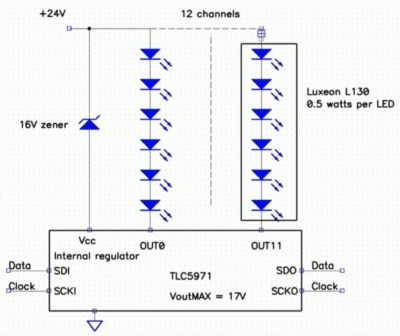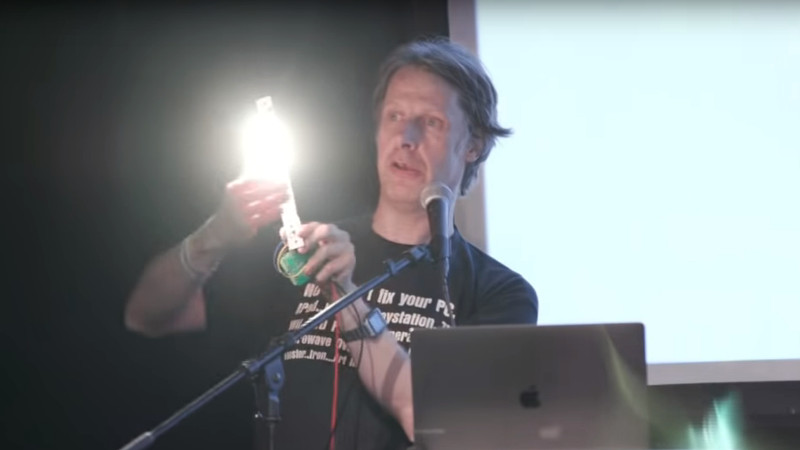Driving an LED and making it flash is probably the first project that most people will have attempted when learning about microprocessor control of hardware. The Arduino and similar boards have an LED fitted, and turning it on and off is a simple introduction to code. So it’s fair to say that many of us will think we have a pretty good handle on driving an LED; connect it to a I/O pin via a resistor and that’s it. If this describes you, then Mike Harrison’s talk at the recent Hackaday Superconference (embedded below) will be an education.
Mike has appeared on these pages multiple times as he pushes LEDs and PCB techniques to their limits, even designing our 2017 Superconference badge, and his many years of work in the upper echelons of professional LED installations have given him an unrivaled expertise. He has built gigantic art projects for airports, museums, and cities. A talk billed as covering everything he’s learned about LEDs them promises to be a special one.
If there’s a surprise in the talk, it’s that he’s talking very little about LEDs themselves. Instead we’re treated to a fundamental primer in how to drive a lot of LEDs, how to do so efficiently, with good brightness and colour resolution, and without falling into design traps. It’s obvious that some of his advice such at that of relying on DIP switches rather than software for configuration of multi-part installations has been learned the hard way.

We are taken through a bit of the background to perceived intensity and gamma correction for the human eyesight. This segues neatly into the question of resolution, for brightness transitions to appear smooth it is necessary to have at least 12 bits, and to deliver that he reaches into his store of microcontroller and driver tips for how to generate PWM at the right bitrate. His favoured driver chip is the Texas TLC5971, so we’re treated to a primer on its operation. A useful tip is to use multiple smaller LEDs rather than a single big one in the quest for brightness, and he shows us how he drives series chains of LEDs from a higher voltage using just the TI chip.
Given the content of the talk this shouldn’t come as a shock, but at the end he reminds us that he doesn’t use all-in-one addressable LEDs such as the WS2932 or APA102. These are the staple of so many projects, but as he points out they are designed for toy type applications and lack the required reliability for a multi-thousand LED install.
Conference talks come in many forms and are always fascinating to hear, but it’s rare to see one that covers such a wide topic from a position of experience. He should write it into a book, we’d buy it!
















The high voltage trick doesn’t really work for many types of chips. If you try to do it on an Arduino for example, the input protection diodes allow current to leak to the +5 V supply, so you can’t actually turn the LEDs off.
You’re relying on the voltage across the diode series dropping low enough that it stops conducting, but the forward voltage drop reduces as the current diminishes, so you’re left with faintly glowing diodes.
Example: http://www.girr.org/girr/tips/tips7/led_vf.gif
The white diode has a nominal forward voltage of about 3.7 Volts, but if you look carefully you can see the die light up at around 2 Volts or so.
The efficiency of the LED goes up as the current goes down, so you can see a faint glow with microamps of leaking current. In fact, if you connect a white LED in series with a red LED, you can point the white LED to light and see the red diode light up just noticeably.
The TritiLED project found that luminous efficiency has a local maximum at roughly 1/100th to 1/10th of the rated current. Above that, thermal effects seem to decrease efficiency. Below that, it was unclear, but the best guess was carrier recombination.
High voltage! Where is this high voltage???????????
Obviously you use driver chips that can handle the full supply voltage you’re using.
It is possible to increase the maximum voltage of a current sink by putting a floating NMOS transistor (rated for your higher voltage) in series with the current sink, gate tied to some voltage within the allowed range of the current sink. I’ve used this on various designs many times. Essentially it just stops conducting when the source and drain of the transistor float up near the gate voltage during the off stage.
The point here was to drive LEDs with a driver that can switch up to 17 Volts, but the LEDs are stringed up and connected to 24 Volts with the idea that when the driver output voltage rises to 17 Volts (off) the voltage difference across the LED string is too small and the LEDs won’t shine.
That works is some cases, with some LED drivers or other chips you might use, but beware.
But where is Shelley Green’s talk?!
Mike Harrison could be a wonderful role-model for Dave Jones.
I think I know what you mean, but could you be specific?
Calm and cool, not hyper and shrill?
Lol, that’s just Dave’s personality. If he acted like Mike Harrison, then he wouldn’t be Dave Jones. Different people for better or worse just behave differently, that’s the world we live in.
To paraphrase Robin Williams–
“Knowing everything about LEDs is like being the best-dressed lady on radio.”
Knowing how radio programmes are made, that might be a very good prospect. You might get to report evening balls and sports events on the spot…
I find it shocking that you’ve recorded the conference in 720p with an interlaced camera…. in 2019. Those cameras were the norm for pro-amateur recording in 2008-2010 timeframe.
seriously… and when and how did you notice allllll these “horrible” effects of interlacing. The video is (I guess, since it seems very stable) made with a tripod and the subject itself hardly moves.
What I appreciate about this video (from a video point of view) is that it was filmed horizontal and that it doesn’t have those wobbly and wavy band (not lines) you see in many fast moving phone videos.
I was there live. The talk was definitely horizontal, but that interlacing? That’s just the way Mike is in person.
(Seriously: you provide a free livestream of an exclusive event, with a speaker who’s probably the world’s foremost expert on the topic at hand, a topic which is near and dear to the hearts of many in our audience, and somebody complains about the video resolution.)
Lol, that’s the internet in a nutshell … damned if you do and damned if you dont
I was there live too, but my wife wasn’t able to make it and watched the live stream. Thanks so much for doing it!
And for the record, she’s never mentioned the video quality.
“mikeselectricstuff”